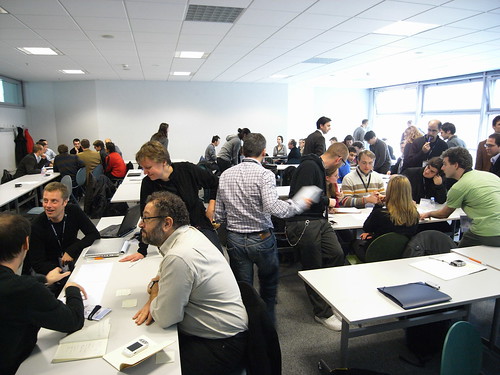My Lift08 Doggie Bag
Posted: February 12th, 2008 | No Comments »The objective to metamorphose the LIFT conference from its grassroot and “groups of friends” origins to become a perfectly ran organizations has been widely achieved. While building a professional profit-generating event, the organizers did not forget about the keys to their previous success: openness (no VIP treatments, nor reserved areas), rely on the community (I only heard positive feedbacks from the workshops and the open stages delivered their pleasant surprises), commercial free, and magic formula of mixing the right amount of entrepreneurs, researchers, designers, artists, journalists and activists.
I attended the conference digitally naked with a pen and pieces of papers as instruments to record notes and thoughts and the archived videos to support my memory:
Bruce Sterling launched the conference in the role of a near-future futurist. Predicting the future is about moral boosting. The main reason people prosper is because they are willing to get out of the bed. Showing up is 90% of the job.
His talk focused on how we can deal (i.e. analyze the driving forces and get on with our own life) with a phenomenon we are certain to be confronted in 2008. He exemplified a foresight method (“you cannot predict the future but you can describe it“) with a recent black swan, the wedding of model Carla Bruni with french president Nicolas Sarkozy . An event that defines the character of our time (especially in Europe). An event that, if we do not have the proper analytical tools, we will be overwhelmed, confused and sicken by it. However, If you we understand the driving forces that guide what is going on we will be able to anticipate the developments. “Like an american who learns the rules of soccer, you probably still won’t like it very much, but you will understand why it matters to people, you’ll be able to put into a useful perceptive and get on with you own life.”
Paul Dourish (video) how we can understand what ethnography can teach us (talk in the following up of his implication for design paper). We miss disciplinary power relationships: ethnographers might regularly be asked what implication for design are, whereas it is not possible to ask a computer scientist the impact of his/her work to social theories. The relevance of classical ethnography in the context of mobility, presence and absence. Symbolism of to define mobility different from the technological perspective (location, coordinates) and the ethnographic perspective (dispora, nomad, asylum). There are different ways to represent space that is not about the cartographic representation (aboriginal vs western, history of the place, identify, different account of space). Particularly relevant to my current project with the senseable city lab (reveal the digital traces) and my taxi driver study (the impact of satnav system on mobility and practices)
Genevieve Bell talked about the armed race of digital deception (quoting James Katz), for every device that aims to tell the truth such as GPS there is a service available to deceive (e.g. alabi service). Technology changes faster than people do (culture, practice). How do we act in social practice with the act of lying or withholding information, the notion of white lies and good lies. Lie is about negating the real, but not about negating the truth (Peter Stiegnitz). Playful act through the rules of the world (how we choose to present ourselves, depending on the knowledge of the lookers). With secrets, we keep safe from what we choose to withhold. With lies, we shape our own realities .”Twitter is making an art out of the form of confabulation“. Particularly relevant to my work on people’s disclosure of location information in Flickr and the granularity they use (attaching a coarse-grained location information can be considered as a good lie). It also touches my taxi driver study as Genevieve points out in the very end of the talk: what do we do if technologies also start to lie such as satnav systems giving a bad direction?
Tom Taylor (video) how to use social network to inflect behaviors in the context of sustainable development. He advocated for the use of positive peer/social pressure. The positive approach goes through the engagement of individuals in groups via social softwares and let people expose their behaviors. In the future we will be able to capturing data from different sources (such as Nike+) and expose them where you do not expect it (Measure, visualize and expose in a social graph). As using a Wattson to monitor the electricity consumption in a house. Tom stated that exposing actions can have a massive effect on the way people behave. In the light of the recent works on persuasive computing, this still needs to be proven (specifically how to make that happen). This work reflects well the intention of WikiCity, its feedback loop, and the use of digital traces for social navigation. An aspect to study would be analyse the spiral of: influencing behaviors that influence the data that influence behaviors the influence the data…
I had a pleasant discussion with Rafi Haladjian on creating innovation and services from the technological constraints. In his career he created success from constraints in the network administration for the Minitel (the importance was not about creating a density of traffic, but by spreading of the day so that line would always be used), the Internet (bet on the physicality of server hosting, the unique link that is not virtual and therefore fragile) and the internet of things (play and take advantage of the positive aspect of immature technologies).
Still to come… the foresight session with Scott Smith, Bill Cockayne and Francesco Cara.
We collected very valuable content from picking up the brains of the 70+ participants of our workshop Ubiquitous computing: visions, failures and new interaction rituals. The feedbacks were rather positive: Mark Meagher, Hannes Gassert, Michele Perras, Vincenzo Pallotta, and Tom Hume.

Group activity at the workshop

